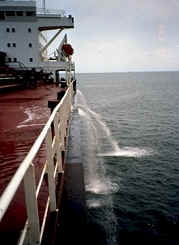This article needs additional citations for verification .(April 2021) |
Ballast is weight placed low in ships to lower their centre of gravity, which increases stability (more technically, to provide a righting moment to resist any heeling moment on the hull). Insufficiently ballasted boats tend to tip or heel excessively in high winds. Too much heel may result in the vessel filling with water and/or capsizing. If a sailing vessel needs to voyage without cargo, then ballast of little or no value will be loaded to keep the vessel upright. Some or all of this ballast will then be discarded when the cargo is loaded.
Contents
- Uses
- Small sailing vessels
- Larger sailing vessels
- Canting keel
- Water ballast
- Sailing vessels
- Powered vessels
- Environmental impacts and regulations
- See also
- References
- External links
If a cargo vessel (such as a tanker, bulk carrier or container ship) wishes to travel empty or partially empty to collect cargo, it must travel "in ballast". This keeps the vessel in trim and keeps the propeller and rudder submerged. Typically, being "in ballast" will mean flooding ballast tanks with sea water. Serious problems may arise when ballast water is discharged, as water-borne organisms can create havoc when deposited in new environments.



